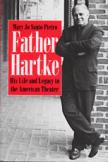Dramatic Dominican
In the course of 50 years in and out of the theatrical spotlight, Vincent Harke, the Dominican priest who founded the renowned Department of Speech and Drama at The Catholic University of America in Washington, D.C., attracted a host of admirers. One of them, a graduate of the department, Mary Jo Santo Pietro, has written an unabashedly affectionate account of Hartke’s life and accomplishments. The legacy that Santo Pietro documents is found not only in the impressive theater program at Catholic University, which Hartke began in 1937, but also most of the other major theatrical institutions in the nation’s capital: Arena Stage, Olney Theater, the restored Ford’s Theater, the John F. Kennedy Center for the Performing Arts and numerous other projects that Hartke helped to create.
Another legacy is represented in the long list of actors, playwrights and critics who began as Hartke’s collaborators or protégés. The esteemed theater critic Walter Kerr came to Catholic University fresh out of college to join Hartke’s first faculty and remained intensely involved in the department’s growth in the 1940’s and its years of triumph in the 70’s and 80’s. Other distinguished theatrical figures, such as the director Alan Schneider and the critic David Richards, cut their theatrical teeth in collaboration with Hartke. The list of the program’s graduates includes such actors as Philip Bosco, Jon Voight, Susan Sarandon, Frances Sternhagen; award-winning playwrights Jean Kerr, Jason Miller, Mart Crowley, Michael Cristofer; and even Johnny Carson’s famous sidekick, Ed McMahon.
Santo Pietro depicts her hero as a high-energy entrepreneur whose priestly character and personal charm provided easy access to the powerful and famous in the worlds of theater and politics. The book is filled with anecdotes involving the likes of George M. Cohan, Eddie Dowling, David Merrick, William Saroyan, Helen Hayes, Carol Channing, Cyril Ritchard, Michael Todd and many other figures of the Broadway theater of a certain era. Hartke also seems to have been on a familiar basis with every president of the United States from Harry Truman to Ronald Reagan (with the possible exception of Richard Nixon, who receives very little mention in the book). House Speaker Tip O’Neill and other powerful members of Congress enjoyed Hartke’s friendship and advice, and even J. Edgar Hoover is reported to have intervened in a matter of security clearance for one of Hartke’s touring actors.
Much of the account resembles an as told to autobiography, as Santo Pietro quotes extensively from the taped interviews she conducted with Hartke weekly during the last year of his life, and the occasional tall tale emerging from these sessions would benefit from some more objective verification. Dozens of photographs testify to Hartke’s achievements in bridging the worlds of religion, theater and politics. Other information has been provided by various histories of Catholic University and its theater department, as well as the journals of Hartke and others, his personal correspondence, the author’s extensive interviews with his friends and colleagues and a mound of magazine and newspaper articles about the man who, in his golden years, was named one of the five most powerful men in Washington, D.C. by Washingtonian magazine.
As Santo Pietro describes Hartke’s adventures in the world of Washington politics, the homes of Hollywood celebrities, the countless back stages in New York City and Washington, not to mention the thickets of religious community life and the public life of the church, one is tempted to wonder if the man ever acquired any enemies. If they existed, they were not interviewed for this book. The one persistent source of opposition to many of Hartke’s plans seems, in this account, to have been Catholic University’s administratorswhom Santo Pietro does not hesitate to charge with numerous instances of condescension, ineptitude and even some financial chicanery, especially during the campaign to build the Hartke Theater on the campus. In the descriptions of these battles with the administration, Father Hartke always ends up on the side of the angels. We should all have such defenders as our biographers.
The book offers only brief glimpses into any darker side of the Hartke story. His early years at the university involved serious disagreements with his fellow Dominicans, Father Urban Nagle and Father Fabian Carey, which were apparently never resolved. His attitude toward his kids in the theater program could be interpreted as paternalistic. The multitude of Hartke’s projects and unorthodox business arrangements tested the organizational skills of his collaborators and assistants. In her few references to Hartke’s activities as a classroom professor or a preacher, Santo Pietro suggests that Hartke did not shine in either of these areas. Not surprisingly, he was not particularly docile when he was asked to accept retirement and relinquish the departmental reins. The author makes occasional references to the insomnia that plagued Hartke for most of his adult life.
Many of Hartke’s plans met with failure, especially his attempts in the 1940’s to forge links between Catholic University and the Hollywood film industry and his later struggles to establish a foothold in the Broadway theater scene. Yet who else could claim responsibility for the production of Long Day’s Journey into Night, which served as Helen Hayes’s last onstage performance.
In her decision to highlight Father Hartke’s multiple achievements and pay scant attention to his struggles and weaknesses, Santo Pietro offers a lively testimonial to a man she deeply revered. Her abundant research has produced a detailed document of the joy, the boldness and the faith of one of the most colorful adventurers of the American Catholic culture.
This article also appeared in print, under the headline “Dramatic Dominican,” in the July 1, 2002, issue.








